It’s the middle of the year as I catch up with Gordon Russell, Head winemaker at Esk Valley, in new surroundings at the Te Awa winery complex now housing the Villa Maria Group’s Hawke’s Bay operations.
WineFolio: How are the changes here coming along?
Gordon Russell: it’s good to see some actual investment in both money and skills, it’s exciting.
WF: People often ask me which wineries are my favourites, and amongst my answers will always be Esk Valley, because you have that entry point that’s available in the supermarket, but also the tiers of wines that are a journey you can take; and see the nuances from one to another, as you climb up to The Terraces.
GR: Totally, and as much love goes into the Pinot Gris as The Terraces, in some degree. Not in the vineyard – as we couldn’t afford that; but in terms of how they’re made and the philosophies on the wines. I also have been lucky enough, with Sir George’s backing, to be able to push the boundaries. Made New Zealand’s first straight Merlot, first straight Malbec, and first Merlot-Malbec blend – as far as I know – in New Zealand. And now it’s a standard blend. New Zealand’s first Verdelho. Co-fermenting The Terraces. Even our rosé was kind of the pioneer back in the day.
WF: You look back now and you can’t quite remember a time when that wasn’t common, but, yes, actually it was.
GR: So I’ve just chosen a few things to showcase Esk Valley as it is today. Now this here is 2020 Pinot Gris, and the reason I’ve got this – literally this morning it was tankered out of the winery to be bottled in Auckland. So I went and saved some before it went out, so I could show you – and you’re the first person outside our winery environment who will have tried the wine. So I thought it was worth trying. It’s a really good vintage of the wine. It’s 100% from the Keltern vineyard. Back in 2001 when we decided to do a Pinot Gris we encouraged a grower in the Esk Valley to plant Pinot Gris for us – which, at the time, was a bold move because there’s wasn’t much Pinot Gris in New Zealand. Mission made one, Trinity Hill had just started making one…. Dry River obviously. But it was an obscure variety as such.
I encouraged the grower because I wanted to make some, effectively. It’s been a long and interesting journey. The vineyard up in the Esk Valley got virus and the yields were dropping off. But there’s quite a lot in Keltern, and I think having it as a variety inland, where it retains its acidity and freshness – and the drier conditions out there – it’s a better site ultimately. And proximity to the winery – to be able to get the fruit straight into the winery and into the press, and not get any pink colour out of the skins and so forth, is a big plus. It’s my block of Pinot Gris in a sea of Chardonnay! It seems to work, for me. Its fermented in barrel old 600 litres demi-muids with wild yeast and also in tank, so it’s a mixture of the two. Texture and perfume. Low acid and a real opulence. I think it should go down a storm.
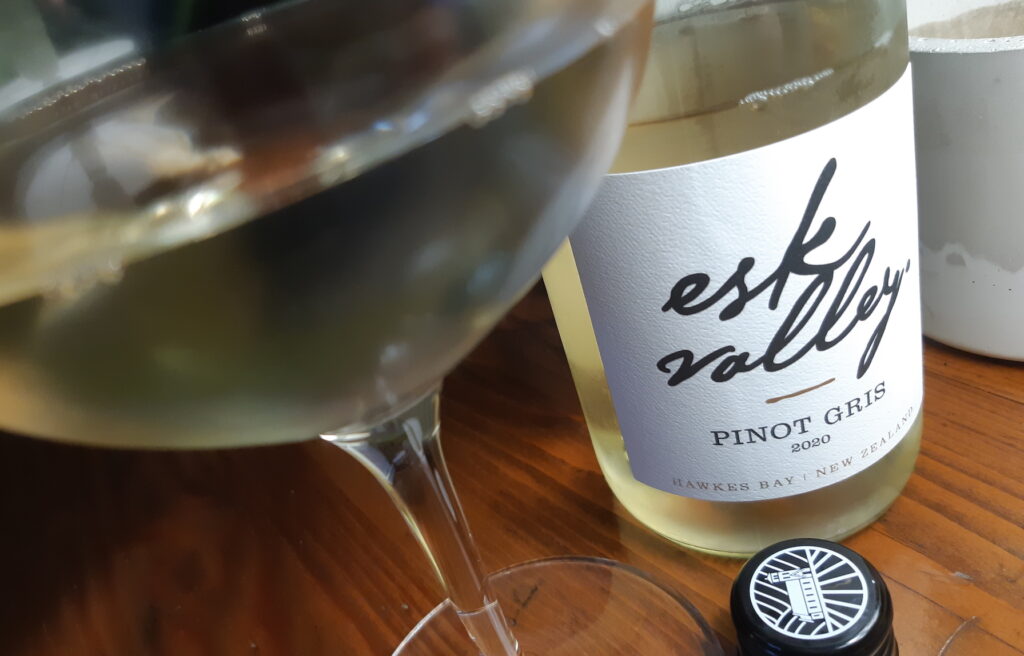
Funnily enough we’ve shifted the Esk Valley wine library cellars over to here. And there’s a lot of old vintages of Pinot Gris, under screwcap going back to 2001.
And so far I’ve opened the 2002, 04, 05 and 07. They’re incredible. The wines mature just absolutely startlingly well. Pinot Gris generally, given its acidity – which tends to be quite low, isn’t a wine you would think of cellaring. If you’d asked me five years ago ‘which of your white wines is least likely to age well?’ I’d have probably said ‘Pinot Gris’. I would change that now. I think the Pinot Gris can outlast our Chardonnays, and may ultimately turn into greater bottles of wine. The Verdelho has unfortunately been pulled out now, but I’ve been trying some of the older vintages of that, and they are magnificent.
This is the Chenin Blanc which you tried recently.
WF: I did, and I liked it a lot. I opened it, tried, it reviewed it and put the review up online as I ran out the door to a tasting… and less than an hour I was served it again, in a blind tasting. I was like “I know this wine!’ It was at First Glass and it was really well received – regarded as the best wine of the night. Which considering it’s a room full of Shiraz and Californian Chardonnay drinkers was pleasing. I was out at the vineyard – at Two Terraces yesterday, and I’ve also tried the other four Chenins off the same vineyard, including Rod Easthope’s – that was the other one I had about the same time as yours.
GR: Those two wines couldn’t be more different in some respects. It’s not the wine I set out to make. But it’s the wine that nature gave me, in some respect. My initial aspiration was to make a wine which was probably more in the line of Rod’s – tight acidity and a lot of tension in the wine and so forth. But, I fermented all of this with wild yeast, both in tank and in barrel. Separated out the 3 different press cuts, and the ferments were really long. A large part of the wine went through malolactic fermentation during that – which it wasn’t meant to do, believe me. That was not anywhere in the planning. But rather than in any way crowbar it into what I wanted, I let it be what it wanted to be.
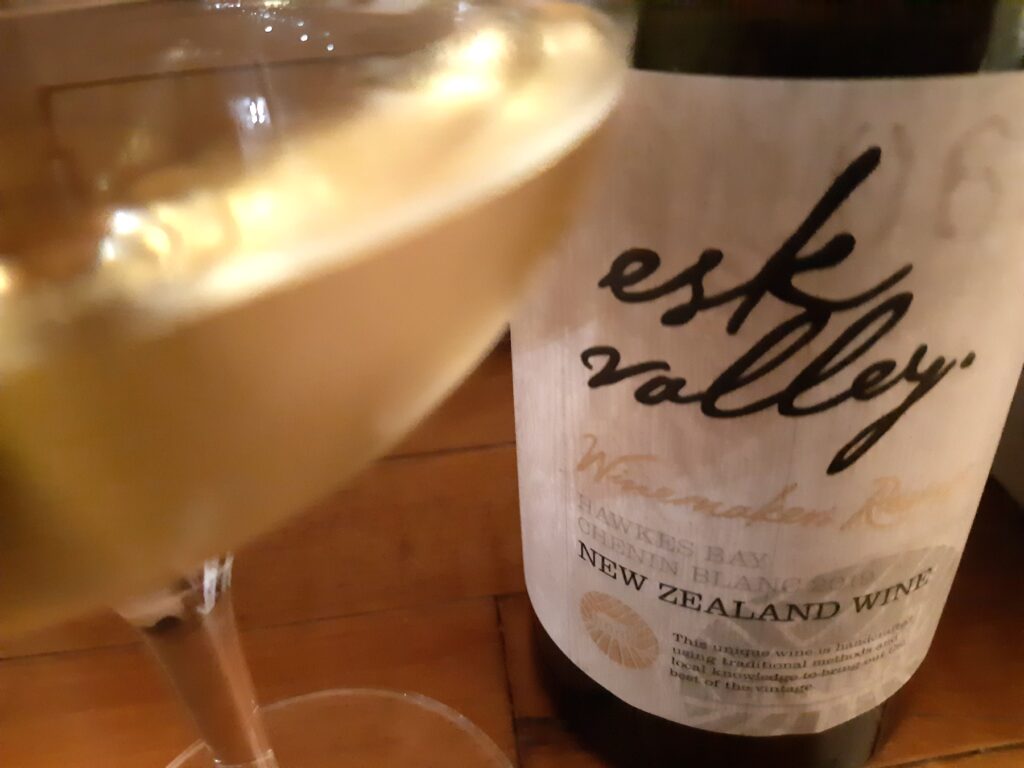
And so ended up with a wine with a lot less acidity, because the malolactic fermentation kind of altered that. If I had more acidity in it, I would have left more sugar in it. This wine doesn’t have that much sugar in it, it’s just that it has a lot of alcohol, softer acidity and some residual sugar. It turned into something unexpected. And I really like it. It smells absolutely incredible. It reminds me sometimes of a young Sauternes wine. And yet the grapes didn’t have any botrytis in them. Perfectly clean, albeit at 24.5 brix or something – so really ripe.
WF: It’s kind of unexpected to drink too. You smell it and you think it might be one thing, and it tastes like something else. And the texture just blows me away!
GR: Well that’s the story in all my wines. The Pinot Gris – Villa Maria want to enter some into the New World Wine Awards, which, for me, means an earlier bottling than I would prefer. I understand, and that’s business. We’ve blended up a volume of wine and bottled a quarter of it. The other three quarters are still in tank on full fermentation lees and will get stirred and stirred, and will become richer, creamier and so forth. The same wine, but, to my mind, the later bottling will have reached my idea of where that wine should be. This wine here (the Chenin Blanc) spent a year in the cellar before bottling. Once again, pushing the boundaries, but it’s got a lot of alcohol and weight, and I just wanted to bring all those things together – until I thought it was ready. That’s become the ‘style‘ of Esk Valley wines.
I spend an inordinate amount of my time going to live music, spending money on music. Music’s my forte rather than art, but then music is art isn’t it?
WF: Arguably wine is such a personal thing, like music is, that is comes down to taste. And I think that’s important. I liked that thing you did in lockdown with some of your music.
GR: I had a stack of records that high, and a story woven around them, and it took five minutes. And it’s like “no-one’s going to watch that for five minutes..” so it became a totally condensed one minute version and didn’t quite gel as I meant it to. But it was fun doing it anyway. In my career I feel so incredibly fortunate to have had a job which obviously at its core is winemaking but its that mix of history, romance, design, food and culture. Wine and wine culture is all-encompassing.
WF: It’s a nice craft isn’t it? It has that sense of artisan craftsmanship to it.
GR: Have you read or come across Andrew Jefford’s work? He writes in a way that is so poetic and evocative. His choice of words – he’s an absolutely brilliant writer, who happens to write about wine.
WF: I’ll have to look it up, because you’re not the first person to have mentioned him to me. I do wonder where wine writing is heading in this world of click bait journalism and influencers? Obviously we do need young people to be drinking wine – it can’t just be about oldies drinking bottles of wine for hundreds of dollars – that’s not the future either. I hope wine doesn’t become an old fashioned thing.
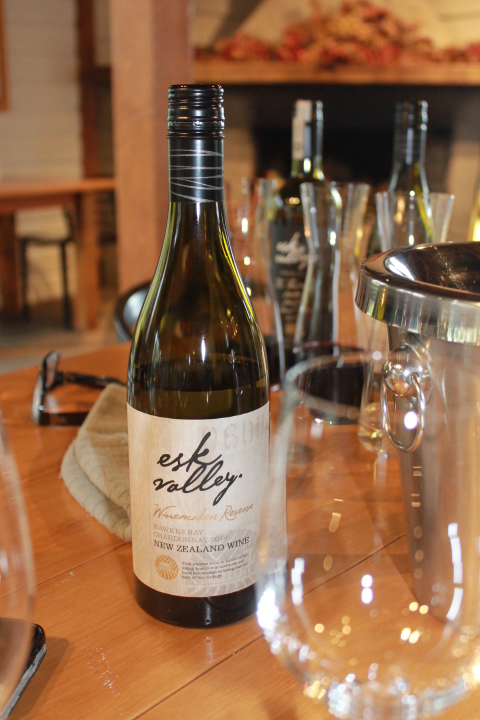
GR: Possibly, but not for ever. Wine is forever reinventing itself. In terms of style, labelling and packaging. I’ve got a daughter who’s absolutely fixated on wine and as much as she loves pet-nats and orange wines, she still wants to drink and learn about these sorts of wines. She’s not alone in that. The more things are underground, the more chance they have again of becoming popular.
WF: That’s interesting. It’s like music again isn’t it? Starts off as weird and underground and hardly anyone likes it; then before you know it, it becomes mainstream.
GR: Now this wine here follows a similar track. This is the Winemaker’s Reserve Chardonnay. Bay View fruit. It’s a vineyard that I’ve been making wine from since 1994. It’s in the backstreets of Bay View – not somewhere you ordinarily associate with fine wine, but it makes our best Chardonnay, so I bottle it on its own.
It’s planted behind the Crab Farm Winery, literally over their back fence. Prior to the 1931 earthquake it was under water. Where Bay View township and this vineyard are located, used to be the old tidal flat for the Esk River. Dig into the soils of this vineyard – shell, marine clay..so it’s growing in ex-marine soils which I always think gives this wine a briney note that I really like. An incredibly complex, rich, smoky wine, with a texture and plushness which is heading more towards Gisborne style of wine. There’s a noticeable difference in the structure and nature to somewhere like Keltern which is inland, and I always cherish that. I like what I’ve got and it’s a point of difference. 2018 – the Chardonnay was slightly lean, but saying that, the earlier we end up picking our Chardonnays, the more we seem to like them anyway. There’s something to be said for that. Given that the wines were slightly skeletal in a way, my role, and goal, in the whole thing was to put flesh on the wine’s bones. Everyone bottled theirs and I left this in barrel for another 5 to 6 months. I stirred it, personally, every week. By the time we took it out it had been in barrel almost 18 months, and it didn’t need any fining, any cold stabilisation, any bentonite – nothing. It was totally just stable, in barrel. This was now very much an Esk Valley style of wine.
WF: I have this list of Chardonnays that I keep, and this is well up there! It’s quite smoky isn’t it?
GR: It’s not the barrels. The new oak would be 30%. I see that slightly salty, briney note in the wine as well. At the end of the palate – I don’t know, it’s salty to me. I would say that everything about this wine is about the vineyard. I loved every week just going over and trying it again, coming to a stage where I thought I’d achieved what I wanted. I’d say “I think next week is going to be it..”
WF: And yet the Chenin didn’t behave and still came out quite beautifully – so you can’t control it all.
GR: the only way you can control it is using a lot more science than I generally tend to use. I like knowing what’s going on and I like knowing how much sugar and acidity we’re starting off with. But it’s working around what we’ve got rather than wanting to change that.
The next wine we’ve got is Syrah – 2014. I poured this last night at Hawke’s Bay Winegrowers event, and we’ve been making this Winemaker’s Reserve Syrah since 2002. It has always come from – if you back up the road there and see the Gimblett Gravels sign on the corner of Gimblett road – the vines that are on that corner right where the sign is – the Cornerstone Vineyard.
Planted in 1996 and, as far as I know, when the first cuttings of vines came from Alan Limmer at Stonecroft, they went to Cornerstone and Trinity Hill. This is the second generation of plantings in Hawke’s Bay. I have always since the first vintage of this wine, in 2001, realised that this particular block of grapes makes our finest syrah. So when it meets my aspirations, we bottle it separately. And this is the 2014 version of it. It was a ripe year but the one thing that separates that block from all our others is, yes it gets ripe, but it also has amazing acidity.
There’s this weird juxtaposition where it has both sugar, alcohol and acidity at the same time. Concrete fermentation, wild yeast, classic Esk Valley style. If you have a wine cellar this is one you’re going to put aside for twenty years, without ever thinking ‘I need to drink that wine’. If you like, the 2014 is more Hermitage, where the ones after are more Cote Rotie.
If you gave an Australian winemaker who’d never tried Cote Rotie before, they would probably dismiss it, and not like it, because it’s not what they’re used to. You’ve got to have an open mind. When I first starting making wine, the concept that I would ever be imagining that we’d be making shiraz in new Zealand? I imagined it was a warm climate grape and just impossible to grow in New Zealand. But it’s not. It’s a mid-climate grape in the respect that it doesn’t need the heat of Cabernet. It’s closer to Pinot Noir as I see it. And I make this wine exactly as I would make Pinot Noir. I don’t think there’s too much difference between this wine and a ripe Bannockburn Pinot Noir.
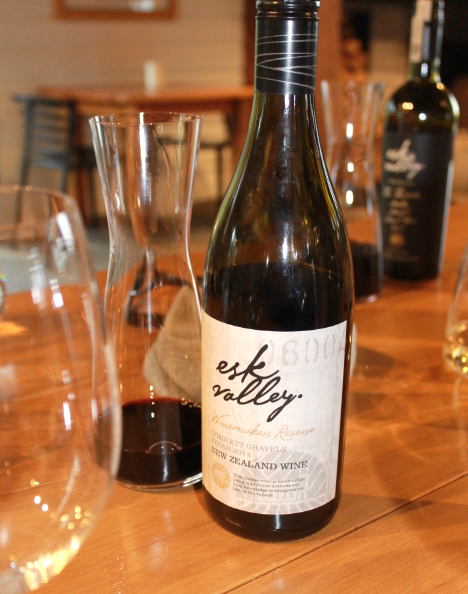
WF <The Terraces gets poured> Oh, here we go – Malbec, merlot, Cabernet franc.. all picked on the same day, from the one vineyard?
GR: Fermented together, aged together and bottled without fining or filtration. When we first decided that was a good thing to do, back in 2001, there was no role model for this in the world. There was Marcel Deiss in Alsace, Paul Draper in Napa who were doing their own version generally. But it just seemed to me that if I wanted to make a wine that spoke of the most beautiful vineyard I get to make wine from – I couldn’t make a blend that was the best post harvest. We needed put all our energy into the vineyard and then let that season and nature decide. So that’s where it’s come from.
I’ve learnt a lot over the years, and it depends on the season, but it’s very Pinot-esque in some respects this wine. We’re not trying to make the biggest, blackest wine – the vineyard doesn’t usually do that. To me it’s about elegance, complexity, soft and mouthfilling.
WF: I find it a very ‘evolving’ wine. One you back to and find more in it. I love having it decanted, and keeping a bit to try the next day; and then it’s whole different wine. It’s very of its place. It’s the most “Hawke’s Bay” wine that I know of having been made. Talk about a wine that’s ‘made in the vineyard!’
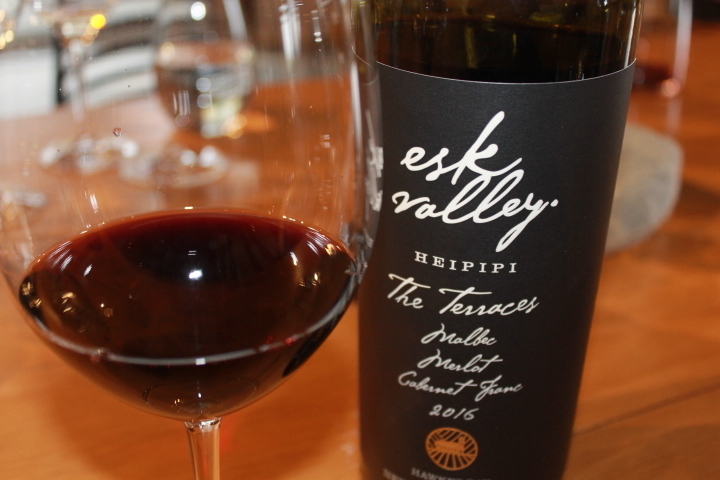
GR: We’ve even now, with the 2018 vintage, taken the varietals off the front. But it’s always different anyway. The 2014 is a big muscular wine. 2013 is really tight and got an incredible iron fist in it. That’s the nature of that harvest.
You’ll drink the 2014 for years before you’ll drink the 2013. Ultimately I think the 2013 will be the great wine of that pair. This 2016 is soft and generous, but there’s tannin lurking in the background. Sometimes when I’ve opened up the older ones at tastings, they’ve looked like Italian wine – they’ve got the acidity in some respect of Chianti, or central italian reds that smell of Bordeaux. We sell a lot of it ‘en primeur’ and some of it goes to Europe, Singapore, Hong Kong. I mean there’s not much of it 350 dozen would be a big year for it. It sells. Some people have got bottles of every vintage and have become friends of the Estate as such.
The second label we created called ‘The Hillside’ is a really good wine as well. The first vintage was 2010 and that was because we just couldn’t make up our minds whether we wanted to release it as The Terraces or not. So we ended up deciding, just by a small margin, that we wouldn’t. But equally thought ‘we can’t sell this off cheap”, given everything that’s gone into it. Then in 2013, I had both too much fruit to fit into the fermenter, and too much merlot in particular. If I’d put it all in it would have made a Merlot-based wine, and I like the Malbec origin. So then I’m defeating everything I’m saying about letting nature decide! So I faced a bit of a conundrum there. There was a small part of the vineyard with some younger vines in it, and I fermented them separately. So in 2013 we have a Terraces and a Hillside, which is pretty damn good. Now 2017 was not a great year for red wines in Hawke’s Bay. It was a very very challenging year. The Terraces withstood everything that was thrown at it. The fruit was phenomenal – really good condition. We harvested late and still got to 23 brix. We decided like in 2010 that it probably didn’t quite get there, but that was a tough call because it’s a remarkably good wine. I’d be very surprised if any other red in Hawke’s Bay matches it.
To round it off, this is our Late Harvest Chenin Blanc, a rare wine. A bit of fun. Some vintages, given the opportunity, we have a crack at making something interesting.
WF: You know I’ve got that old one – I think it’s a 1992, with the old label?
GR: That will be a cracker. So this is a folly – an Esk Valley folly. I’m trying to teach people in some respect that this isn’t necessarily a dessert wine, a pudding wine. Go to France and you start your meal with this. Have your foie gras, and start sweet, and then you drink dry after that. This is sweet, yes, but Chenin Blanc has incredible acidity, and it’s a great grape to make sweet wine from.
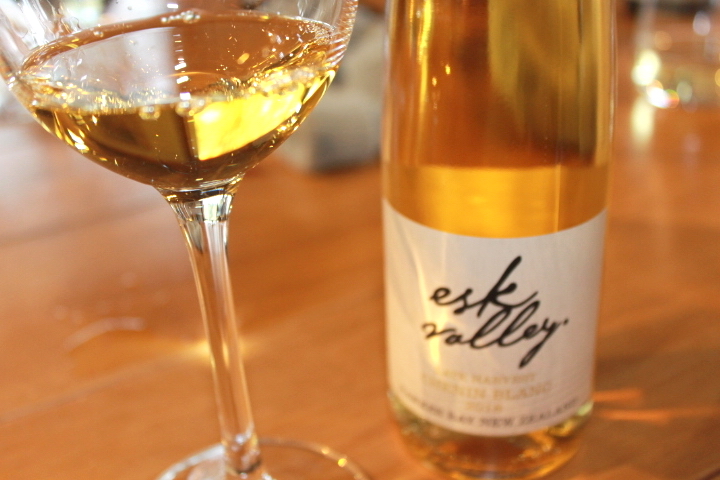
WF: Can you make a sweet wine from lots of different varietals?
GR: Generally I think the best ones are the ones with high acidity, so you’re going to get good acidity from something like Riesling. Some just don’t rot – Verdelho, Albarino..
WF: Aha – you’ve said the magic word! This is what I wanted to know…tell me about your Albarino!? What are you doing with it?
GR: It comes from Two Terraces, but once again, this was a challenging pick. When we got the grapes here they were 25 brix, which is stupidly high, and yet the grapes did not look ripe. They were either bright green or a some golden ones, and you taste the green ones think ‘I can’t make wine from this’ but finally you get to the stage where you can believe the sample result. Ran the juice to the same vessels as the Chenin Blanc – tank and barrel, wild yeast, and they’re still there. Looked at them yesterday. I’ve got three different portions – some free run that I ran to tank; middle cut that I ran to tank, and then the last, harder pressings – and with this variety that has lots of flavours in the skins – kept separate as I thought it would have lots of interesting flavour. And these are first crop grapes as well. What came out the press and went to barrel was 25 brix and an acid of about 10. Nick and Rich said neither of them had tasted a wine that was so assaulting. Smells fabulous and it’s rich, and then it’s got searing acidity. It’s so bizarre and challenging.
What I fermented in tank, I left a few grams of sugar in, knowing that I would blend the two together, to tame the acidity a bit. And when we looked at it yesterday, the pressings were tasting really good, and I ended up blending the whole lot up together – every drop that came out of those grapes. And I got it tested in the lab, and I don’t know what the alcohol is on it, but all the results fitted together almost perfectly. It’s going to be a robust wine. It’s probably, once again, not what I was expecting of an albarino. I was thinking of more of 12.5% alcohol, and a really quenching summer wine. Instead what we’ve got is a really rich, intensely flavoured wine which will be totally memorable. I’m in no hurry to bottle that, I’m looking to mellow it with lees stirring and soften the edges. Most of it will go to the UK and we’ll keep maybe 80 cases to sell through the Cellar Door here. In fact, make a note to contact me in 6 months time and I’ll send you a bottle!
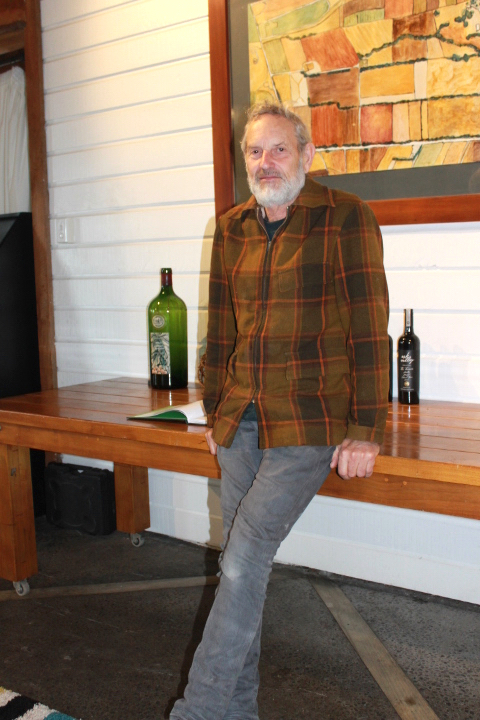

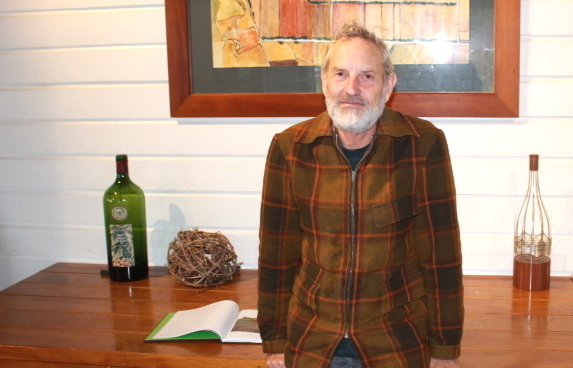


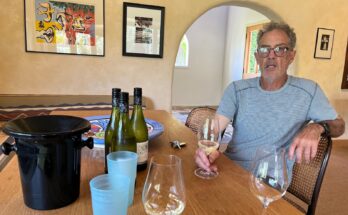
What a phenomenal winemaker and the best of Hawkes Bay wines. I would love to know the future for Esk Valley, I hope it all carries on.
Brilliant interview, thanks.
Gary Carter
Thanks for reading Gary – keep dropping in for more.